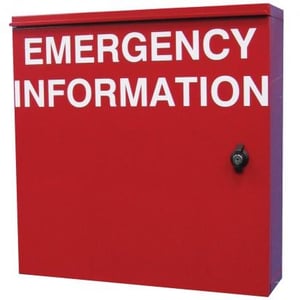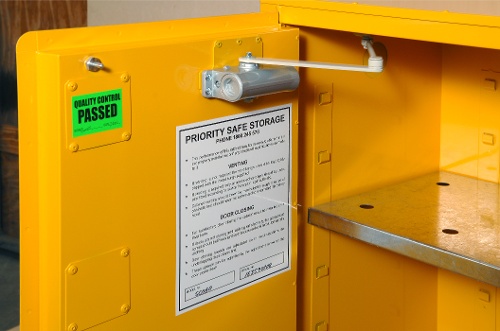We often post about the hazards associated with dangerous goods, but one of the most notable incidents that can occur with onsite chemicals is also one that can be prevented. A chemical fire can ravage businesses – burning down manufacturing plants, oil rigs, restaurants, tankers, office buildings or warehouses. These fires can start unexpectedly and cause fatalities, as well as serious health issues for surrounding communities, in addition to environmental damage and property destruction.
While other types of fires, such as bushfires or electrical fires can be just as devastating, a chemical fire can also produce additional hazards which may increase the level and complexity of the danger.
In this post, we’ll look at some of the reasons a chemical fire can break out, and what steps you can take in your own business to reduce the impact and likelihood of it occurring in your workplace.
Understanding Chemical Fires
When it comes to understanding the very basics of combustion and fires, there is a simple equation that can be used.
A fire requires 3 elements, which are:
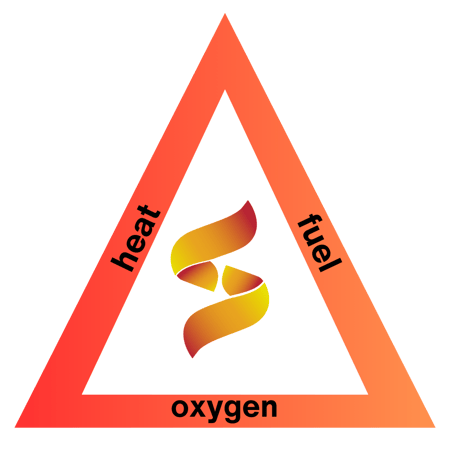
Without these 3 ingredients, a fire cannot form. While combustible materials such as timber, paper or refuse may be a common fuel for many types of fires, a chemical fire is one in which the fuel is chemical in nature.
Fuelling a Chemical Fire
A chemical fire is a blaze that occurs when a chemical reaction ignites a chemical compound. To prevent chemical fires, it’s important to understand the chemicals that your workplace is carrying, so you can determine controls to prevent ignition of the substance or vapour, as well as the control of the fire itself.
A chemical fire, like any fire, relies on the presence of three key elements known as the fire triangle: fuel, oxygen, and heat. Without these elements, a fire cannot start or sustain itself. Here's how each element relates to a chemical fire:
- Heat: Heat is the initial energy source that raises the temperature of the fuel to its ignition point, at which it begins to vaporise and react with oxygen. Once the fuel reaches this ignition temperature, it can self-sustain combustion if sufficient fuel and oxygen are available. Heat can come from various sources, such as open flames, electrical sparks, or external heat sources.
- Fuel: The fuel in a chemical fire can be a wide range of substances, including liquids, gases, solids, or even combinations of these. Common flammable chemicals include solvents, fuels, industrial chemicals, and many organic compounds. The fuel in a chemical fire is the substance that undergoes combustion, releasing energy in the form of heat and light.
- Oxygen: Oxygen is a critical component for combustion to occur. When a chemical fire ignites, it combines with oxygen from the surrounding air to support the chemical reactions that release heat and sustain the fire. The presence of oxygen is essential for most fires to continue burning.
Chemicals That May Contribute to or Cause Combustion
There are many chemicals that are flammable – and others that may produce an exothermic reaction if they are kept in unsafe circumstances or are exposed to incompatible substances.
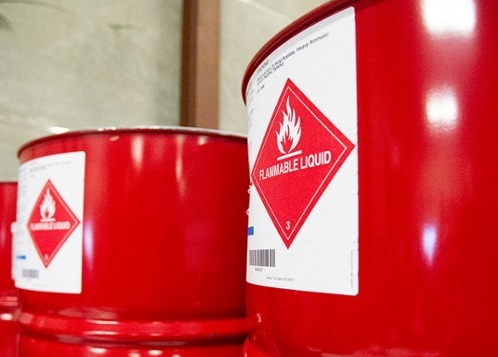
Flammable liquids on the worksite must be handled and stored in a way that prevents ignition and a chemical fire.
Chemicals and dangerous goods that must be controlled due to the risk of combustion or explosion include:
- Class 1 Explosives
- Class 2 Gases
- Class 3 Flammable Liquids
- Class 4 Flammable Solids
- Class 4.2 Spontaneously Combustible
- Class 4.3 Dangerous When Wet
- Class 5.1 Organic Peroxides
- Class 5.2 Oxidising Agents
Examples of Chemical Fires
You don’t have to look far to find a news article or video about a chemical fire. Here are just three examples of highly destructive chemical fires that have occurred at workplaces across the world:
Fire Ball at Toronto Chemical Plant
Motor oil was the fuel that caused a six-alarm fire in Toronto. Over 100 firefighters and first responders helped to control the blaze. While no injuries occurred, local businesses were closed or evacuated during the incident. Fire crews mentioned the presence of solvents onsite, but were relieved that the fire did not reach these chemical products.
Massive Chemical Fire in Melbourne Waste Storage Facility
A Campbellfield factory that manages hazardous chemical waste was at the centre of a massive chemical fire, which sent acidy smoke across Melbourne. Over 175 firefighters attended the blaze, which was thought to have been sparked by a forklift. Authorities issues a warning to surrounding suburbs to “take shelter indoors immediately.”
Chemical Warehouse Fire in Perth Triggers Explosion
A fire that engulfed a chemical warehouse in Perth's south triggered an explosion that was felt by people 35km away. Fire crews battled the blaze at the Chemsol Australia factory for around an hour before a massive blast was triggered.
"There was an incident with some chemicals that reacted causing an explosion in the property, causing total loss of the property," said WA Department of Fire and Emergency Services district officer, Ryan Murray. Sand and foam were used to extinguish the blaze, which burned for approximately 12 hours.
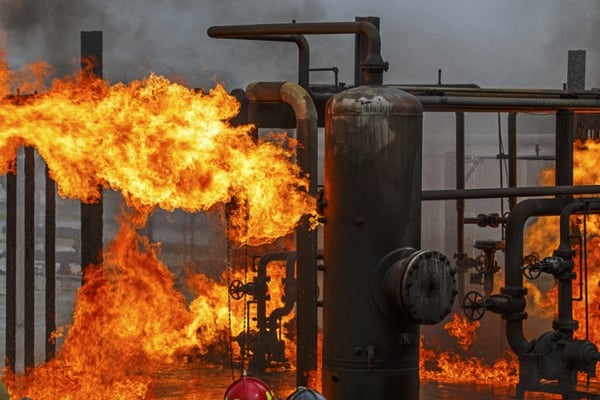
Chemical fires can occur at workplaces of all sizes, across all types of industries including plants, mining, hospitality venues and manufacturing.
Fighting a Chemical Fire
These fires pose a range of risks to those in the workplace and the surrounding community, as well as the first responders and firefighters that attend the scene. When Triple 0 is called, your fire services will take control of the site, liasing with other first responders and your people, determining the extent of the fire and isolating the area. Fire services will also identify and define the problem.
In some cases, chemical fires can be challenging to extinguish because the fuel may be highly reactive and self-sustaining, even without an external heat source.
Specialised firefighting techniques and equipment are often required to combat chemical fires, especially if the chemicals involved are hazardous or toxic.
It's important to note that the nature of the fuel and the specific chemical reactions taking place can significantly influence the characteristics and dangers of a chemical fire. Different types of fires may require distinct firefighting methods and safety precautions to control and mitigate the situation effectively.
It’s vitally important to have clear documentation available for fire services on the types and volumes of chemicals at your site. If your workplace has a notifiable quantity of hazardous chemicals, you’re required to develop an Emergency Plan and submit a copy of this to the Fire Services in your area.
REMEMBER: Schedule 11 of the WHS Regulations details the Manifest Quantities of Hazardous Chemicals.
Store your Manifest in a clearly marked Emergency Information box so the documents can be quickly accessed by fire crews attending your site.
Preventing a Chemical Fire
There are multiple levels of controls required to reduce the risk of a chemical fire from occurring in a work situation.
From having safe storage of chemicals to being equipped with the right fire protection equipment and ensuring all emergency and evactuation plans are up to date, it's important to take a comprehensive risk management approach when considering the potential for a chemical fire.
To prevent a chemical fire, consider:
- Understanding of the chemicals kept onsite
- Safe handling and storage techniques
- Segregation of incompatible substances
- Staff training and supervision when working with substances liable for combustion
- Spill containment and bunding
- Prompt clean-ups of any leaks and spills in the workplace
- Implementation of handling equipment to reduce spill risk
- Control and isolation of ignition sources
- Adequate ventilation to control vapours that may ignite
- Minimisation of combustible materials onsite
- Reduction of outdoor trees, bushes and debris
- Dangerous goods and hazard signage, including no ignition source signs
- Regular maintenance and integrity testing of equipment
- Suitable fire alert systems and firefighting equipment
- Applicable fire suppression systems
- Evacuation and emergency procedures
- Regular risk assessments and updating of controls
- Sufficient emergency decontamination equipment onsite
- Register and Manifest of hazardous chemicals must be up to date
- Emergency Information box should be accessible for fire crews
Important Fire Safety Information in Safety Data Sheets
Your safety data sheets provide essential information that is important for fire control and prevention. You should pay extra attention to the following sections of your safety data sheet – and incorporate this data into your risk assessment.
Make sure your staff and management understand the following guidelines for each chemical you have in your workplace:
- Auto-ignition: most flammable liquids have an auto-ignition temperature. Chemicals used or stored within their auto-ignition temperature range don’t need an ignition source to ignite.
- Flash point: the flash point of a substance is the temperature range in which the chemical will burn. Your fire risk assessment should consider if the chemicals you hold onsite are used or stored at temperatures inside the flash point range.
- Explosive range: some chemicals also have an explosive range, which means that they will explode if temperatures and vapour concentrations hit a certain point. When conducting risk assessments at your workplace, make sure you include the possibility of these chemicals reaching their explosive range.
- Flashback: When there is an open chemical container or an accidental release (such as a chemical spill) flammable vapours can travel long distances. You must consider the likelihood and impact of a flammable vapour trail when controlling fire risk at your worksite.
REMEMBER: Your safety sheets will also offer information on the correct firefighting procedures for the chemicals that you carry at your worksite. Spill prevention, correct storage, safe handling procedures and general hazard awareness information can also be found in your SDS.
Control of Ignition Sources
The Australian Standards offers a definition of an ignition source:
A source of energy sufficient to ignite a flammable or explosive atmosphere. Examples of ignition sources include naked flames, hot surfaces, exposed incandescent material, electrical wiring arcs, mechanical or static sparks, hot particles, electrical discharge, and electrical or mechanical equipment not suitable for use in hazardous locations.
In workplaces, ignition sources can be static (such as electric work) or brought onto the site unintentionally by staff or visitors (ie. a lighter).
Ignition sources not only start fires through the ignition of combustible materials; they can spark a blaze through the ignition of vapours in the air. This means that there must be strict controls set (guided by your safety data sheets) to avoid ignition sources near your dangerous goods and hazardous chemicals.
Some commonly found sources of ignition may be:
- Naked flames: matches, lighters, bunsen burners, pilot lights.
- Hot surfaces: cigarettes, hotplates, welders or flame cutting equipment, machinery that has overheated or malfunctioned, friction from loose belts and worn bearings.
- Exposed incandescent materials: incandescent light bulbs, halogen lights.
- Electrical wiring arcs: loose wiring and faulty electrical connections.
- Mechanical or static sparks: grinders, electric drills, spark ignition systems, hand tools.
- Hot particles: welding slag and hot metals.
- Electrical discharge: power points, light switches, static electricity.
- Electrical or mechanical equipment: if equipment is not suitable for use in hazardous areas, ignition may occur.
Importance of Correct Storage and Handling Equipment
When working with dangerous goods, the correct storage and handing equipment can greatly reduce the risk of a chemical fire.
Compliant storage provides a range of necessary controls, including:
- Spill containment
- Segregation
- Security
Depending on the type of chemical stored and whether it’s stored indoors our out, there is also the provision for either adequate ventilation or vapour containment to prevent flammable vapours from meeting an ignition source.
Some safety cabinets also have special components that reduce fire risk, including magnetic closing doors that open when pressure builds within the cabinet, thermal air barriers to reduce fire and heat radiation, and self-closing, tight-fitting doors to contain vapours.
The requirements of the Australian Standards determine the features of the cabinet, pertaining to the hazards associated with that class. Outdoor storage features vary due to the challenges of storage in the outdoor environment, but they also provide compliance and risk reduction with the necessary built-in controls.
Dual skinned construction and thermal air barrier help reduce heat and fire radiation.
Handling equipment is also important for the reduction of leak and spill risk. When moving drums, IBCs or even chemical containers or gas cylinders around the work site, safety is of the utmost importance. Dropping a gas cylinder or spilling a chemical container of flammable liquids can turn into a fire or explosion.
Handling equipment – along with proper operating procedures and staff training – can help improve health and safety in workplaces, and reduce the risk of fire and other hazards.
Risk Assessment to Control Fire Risk
The other key consideration when controlling chemical fire risks is to get a comprehensive overview of your workplace and the likelihood and potential impact of an incident, such as a chemical fire. Risk assessments are crucial for identifying, assessing and controlling chemical hazards. However, it can sometimes be difficult knowing where to start.
And that’s where our eBook comes in. Grab a copy of our helpful guide to learn more about the risk assessment process and how it can work for your organisation.

Living life by the 4 C’s of marketing – communication, coffee, compliance… and more coffee – Leisa Andersen is Storemasta’s Content Marketing Manager. When she’s not writing, you’ll find her enjoying all the good things in life, including shopping, travel and gluten free donuts.
